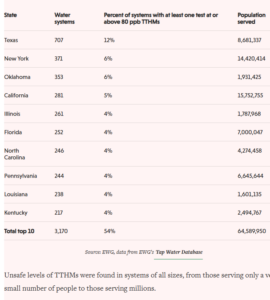Thousands of US water systems show dangerous levels of cancer-causing chemicals
Millions of people across the United States could be drinking water contaminated with dangerous levels of substances created when utilities disinfect water tainted with animal manure and other pollutants, according to a report released Thursday.
An analysis of testing results from community water systems in 49 states found that nearly 6,000 such systems serving 122 million people recorded an unsafe level of chemicals known as trihalomethanes at least once during testing from 2019 to 2023.
The chemicals are byproducts created when chlorine or other disinfectants used by water systems interact with organic matter, such as decaying leaves, vegetation, human or animal waste and other substances. One or more of these chemicals – chloroform, bromodichloromethane, dibromochloromethane, and bromoform – have been linked to various human health risks, including cancers. As a result, the Environmental Protection Agency (EPA) has set a maximum allowable annual average level of 80 parts per billion (ppb) for what the agency calls “total trihalomethanes” or TTHMs. The rule, which applies to public water systems, has been in place for more than two decades.
Texas water systems had the highest prevalence of water systems with unsafe levels of TTHMs, with more than 700 such systems serving over 8.6 million people reporting the contaminants above the EPA’s 80 ppb, according to the report issued April 10 by the Environmental Working Group (EWG).
New York, Oklahoma, California and Illinois followed Texas with hundreds of water systems in each of those states showing higher-than-allowed levels of TTHMs during the testing period, the EWG report found. More than 64.5 million people are served by 3,170 systems in the ten states that had the most violations.
“Manure from factory farms is polluting our water supplies, and when utilities try to make that water safe to drink, they unintentionally create another public health hazard that increases the risk of cancer and birth defects,” Anne Schechinger, EWG’s Midwest director, said in a statement accompanying the release of the report.
The EWG report draws a connection between the high levels of TTHMs and large-scale livestock operations, sometimes called concentrated animal feeding operations, or CAFOs. Six of the 10 states that had systems where testing showed contamination at or above the EPA’s “maximum contaminant level” (MCL) of 80 ppb at least once from 2019-2023, are among the states with the most cattle, poultry and/or hogs, according to US Department of Agriculture (USDA) data.
Many community water systems rely on reservoirs and other surface waters for drinking water supplies, which are frequently contaminated with runoff from farm fields, including pesticides and animal manure.
While the report focused on water systems with levels above the EPA’s MCL, scientific evidence in recent years has indicated that THM in drinking water at levels below the current regulatory limits still increases the risks of certain cancers. People can also be put at risk via inhalation while showering, according to research.
Several studies have linked TTHM exposure to bladder and colorectal cancers, and some research has additionally found that problems during pregnancy, including stillbirth, can be linked to consumption of water containing TTHMs during pregnancy.
EWG’s health guideline for TTHMS in drinking water is 0.15 ppb, representing a one-in-a-million lifetime cancer risk as shown by EWG research.
There is no reason to think the unsafe levels have been mitigated since 2023, the ending period for the testing covered in the EWG report. Ongoing violations continue.
In February, city officials in Battle Creek, Michigan, found excessively high TTHM levels in that city’s water system.
In November, the city of San Angelo, Texas, was notified that its water exceeded the EPA’s allowable levels for TTHMs.
And in December, the Texas Commission on Environmental Quality notified the Goodfellow Air Force Base that the community’s drinking water also exceeded the safe levels.
“Some people who drink water containing trihalomethanes in excess of the MCL over many years may experience problems with their liver, kidney, or central nervous systems, and may have an increased risk of getting cancer,” the state agency warned.
(Featured photo by Engin Akyurt on Unsplash.)
 EWG
EWG


